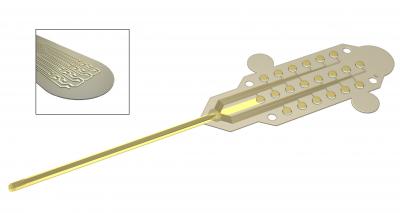Researchers from the Graphene Flagship have developed a new graphene-based device able to record brain activity in high resolution while maintaining excellent signal to noise ratio (SNR). Based on graphene field-effect transistors, the flexible devices have to potential to open up new possibilities for the development of functional implants and interfaces.

Neural activity is detected through the electric fields generated when neurons fire. These fields are highly localized, so having ultra-small measuring devices that can be densely packed is important for accurate brain readings. The graphene-based probes are reportedly competitive with state-of-the-art platinum electrode arrays and have the benefits of intrinsic signal amplification and a better signal-to-noise performance when scaled down to very small sizes. This will allow for more densely packed and higher resolution probes, vital for precision mapping of brain activity. The inherent amplification property of the transistor also removes the need for a pre-amplification close to the probe a requirement for metal electrodes.
The devices were used to record the large signals generated by pre-epileptic activity in rats, as well as the smaller levels of brain activity during sleep and in response to visual light stimulation. These types of activities lead to much smaller electrical signals, and are at the level of typical brain activity. The graphene transistor probes showed excellent performance, with a high SNR and good spatial discrimination of the brain activity.
The neural probes are placed directly on the surface of the brain, so safety is critically important. Graphene is one of the few materials that allows recording in a transistor configuration and simultaneously complies with all other requirements for neural probes such as flexibility, biocompability and chemical stability. said the team. Importantly, the researchers determined that the graphene-based probes are non-toxic, and did not induce any significant inflammation.
This work represents a first step towards the use of graphene in research as well as clinical neural devices, showing that graphene-based technologies can deliver the high resolution and high SNR needed for these applications. Graphene neural interfaces have shown already a great potential, but we have to improve on the yield and homogeneity of the device production in order to advance towards a real technology, said the Deputy of the Graphene Flagship Biomedical Technologies work package. Once we have demonstrated the proof of concept in animal studies, the next goal will be to work towards the first human clinical trial with graphene devices during intraoperative mapping of the brain. This means addressing all regulatory issues associated to medical devices such as safety, biocompatibility, etc.
The research was the result of a collaborative effort involving Flagship partners Technical University of Munich (TU Munich; Germany), Institut d'Investigacions Biomèdiques August Pi i Sunyer (IDIBAPS; Spain), Spanish National Research Council (CSIC; Spain), The Biomedical Research Networking Center in Bioengineering, Biomaterials and Nanomedicine (CIBER-BBN; Spain) and the Catalan Institute of Nanoscience and Nanotechnology (ICN2; Spain).